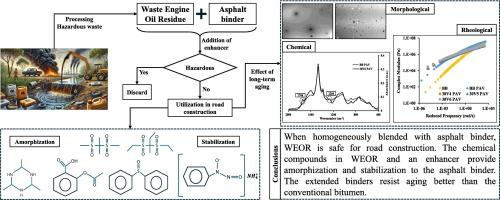利用废机油渣在道路建设中实现可持续发展
IF 9.2
2区 工程技术
Q1 ENERGY & FUELS
引用次数: 0
摘要
有几种废物在所有国家都大量存在,它们的处置正在对环境造成危害。不恰当地处理这些资源可能会对生物造成危害。在本研究中,考虑了其中一种资源,废发动机机油残渣(WEOR),用于部分替代沥青粘合剂。WEOR含有复杂的污染物混合物,包括重金属、多芳烃(PAHs)和其他有害物质,需要小心处理。本研究旨在探索WEOR在沥青粘结剂中的环保利用,并对其长期老化后的性能进行评价。本研究分为两部分。第一部分是对WEOR的使用进行环境检查,第二部分是对经WEOR改性的沥青粘结剂的性能变化进行评估。环境试验表明,在将WEOR与沥青粘合剂混合的过程中,没有显著的重金属浓度,也没有向大气中排放硫化氢(H2S)气体。x射线衍射分析表明,在WEOR中引入热塑性共聚物(TPC)导致沥青粘结剂的非晶化(增强弹性)和稳定。这种非晶化现象有助于延长粘合剂抵抗老化过程,荧光显微镜和傅里叶变换红外光谱定量显示,PP参数和化学老化指数分别降低了53%和13%。老化后延长型粘结剂的性能优于常规沥青粘结剂,复合模量位移参数降低达50.6个单位。因此,少量掺加TPC的WEOR是一种可持续的材料,可以减少道路施工中沥青粘结剂的消耗。本文章由计算机程序翻译,如有差异,请以英文原文为准。

Use of waste engine oil residue for sustainability in road construction
There are several waste materials that are abundantly available in all countries, and their disposal is causing harm to the environment. Handling these resources improperly can be hazardous to living beings. In this research, one such resource, waste engine oil residue (WEOR), is considered for the partial replacement of the asphalt binder. WEOR contains a complex mixture of pollutants, including heavy metals, polyaromatic hydrocarbons (PAHs), and other harmful substances, which require careful handling. This study aims to explore environment-friendly utilization of WEOR in the asphalt binders and evaluate its performance after long-term aging. The study is divided into two parts. The first part consists of an environmental check for the utilization of WEOR, and the second part evaluates the performance change of the asphalt binder modified with WEOR. The environmental tests show no significant concentrations of heavy metals and no emission of hydrogen sulfide (H2S) gas into the atmosphere while blending WEOR with asphalt binder. The X-ray diffraction analysis indicated that the introduction of thermoplastic copolymer (TPC) with the WEOR led to amorphization (enhanced elasticity) and stabilization in the asphalt binder. This phenomenon of amorphization helped the extended binders resist the aging process, as quantified by fluorescence microscopy and Fourier transform infrared spectroscopy, showed a reduction in PP parameter and chemical aging index by up to 53 % and 13 %, respectively. The performance of the extended binders after aging was better than that of conventional asphalt binders, which was observed with the reduction in complex modulus shifting parameter up to 50.6 units in extended binders. Therefore, WEOR, with a small portion of TPC, was found to be a sustainable material to reduce the consumption of asphalt binders in road construction.
求助全文
通过发布文献求助,成功后即可免费获取论文全文。
去求助
来源期刊

Sustainable Materials and Technologies
Energy-Renewable Energy, Sustainability and the Environment
CiteScore
13.40
自引率
4.20%
发文量
158
审稿时长
45 days
期刊介绍:
Sustainable Materials and Technologies (SM&T), an international, cross-disciplinary, fully open access journal published by Elsevier, focuses on original full-length research articles and reviews. It covers applied or fundamental science of nano-, micro-, meso-, and macro-scale aspects of materials and technologies for sustainable development. SM&T gives special attention to contributions that bridge the knowledge gap between materials and system designs.
 求助内容:
求助内容: 应助结果提醒方式:
应助结果提醒方式:


